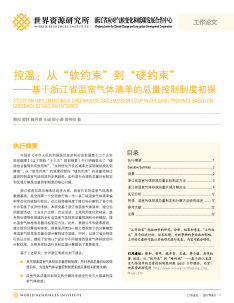Study on Implementing A Greenhouse Gas Emissions Cap in Zhejiang Province based on Greenhouse Gas Inventories
Zhejiang was the first province to institutionalize greenhouse gas (GHG) emissions inventories at province, city, and county level and therefore has a solid foundation for GHG emissions data. It also has implemented an emissions intensity goal, and established an allocation and performance appraisal mechanism for cities. Based on the GHG emissions inventories, this paper establishes a comprehensive model to set a volume-based GHG cap goal for the province that covers all emissions from the energy, industrial processes, agriculture, forestry, and waste sectors. This paper also establishes an allocation methodology for cities that takes into account both equity and efficiency.

China’s 13th Five Year Plan has clearly established the goals of effectively controlling total carbon emissions, and supporting early peaking of emissions from the developed zones. It is highly likely that carbon emission management will move from intensity controls to cap controls. The key questions are how to set a target cap and establish a reasonable allocation model for cities.
Zhejiang is a developed province in the eastern coastal area of China. Its GDP in 2016 was RMB 4,648.5 billion, ranking fourth in the nation. Zhejiang was the first province to institutionalize greenhouse gas (GHG) emissions inventories at province, city, and county level and therefore has a solid foundation for GHG emissions data. It also has implemented an emissions intensity goal, and established an allocation and performance appraisal mechanism for cities. Based on the GHG emissions inventories, this paper establishes a comprehensive model to set a volume-based GHG cap goal for the province that covers all emissions from the energy, industrial processes, agriculture, forestry, and waste sectors. This paper also establishes an allocation methodology for cities that takes into account both equity and efficiency. It develops an indicator system to measure the responsibility and capability of cities. Finally, this paper simulates a plan for Zhejiang’s 11 cities, and provides an important reference for future policymaking and implementation.
Based on the analysis, this paper proposes four actions for Zhejiang province:
- Regulate both the intensity and the volume of emissions at province and city level to champion the idea of implementing the carbon cap, and provide institutional support.
- Consider all sectors and all GHGs rather than only carbon dioxide emissions from the energy sector.
- Phase in the emission allocations, by allocating the “incremental emissions” in the 13th five-year period, “incremental plus historic emissions” in the medium term, and the whole cap in the long term.
- Pilot the use of the intensity and cap controls in cities that are sufficiently prepared for implementation.
